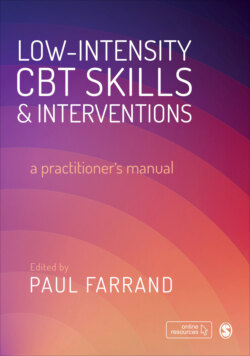Читать книгу Low-intensity CBT Skills and Interventions - Группа авторов - Страница 46
На сайте Литреса книга снята с продажи.
Procedural Case Vignette-Based Question
ОглавлениеIdentify eight examples in the case vignette where the low-intensity CBT psychological therapy practitioner is not working in a manner consistent with low-intensity CBT. (Question worth 16 marks; 2 marks per answer.)
Ellis, a low-intensity CBT psychological therapy practitioner, has recently assessed Ms Lashmay. At the start of the assessment session Ellis introduced herself and her role as a therapist in the Horizon Mental Health Service. Ellis began the assessment by asking Ms Lashmay what brought her to the service for an assessment and soon recognised that Ms Lashmay was possibly struggling with ‘social anxiety'. To confirm this possibility, Ellis said, ‘People with social anxiety may worry about saying something stupid. Can I ask what would be so bad about that?’ The answer confirmed to Ellis that Ms Lashmay was indeed struggling with social anxiety and introduced the required outcome measures. Ellis fed the outcome measures back and said that because Ms Lashmay only had mild social anxiety, she would work with her delivering evidence-based CBT self-help interventions face to face, usually taking about eight to ten sessions of 60 minutes. Ellis indicated that given that this was based around CBT self-help materials, the time Ms Lashmay would engage with treatment would be less than if Ms Lashmay was to use high-intensity CBT. Ellis recommended a CBT self-help workbook called Be at Ease with Yourself and Others. She highlighted the fact that she had used this with other patients who reported finding it really helpful, especially liking the behavioural activation and cognitive restructuring intervention alongside the compassion-focused approach.
Answers to Assessing Your Understanding questions can be found in the appendix on p. 333
